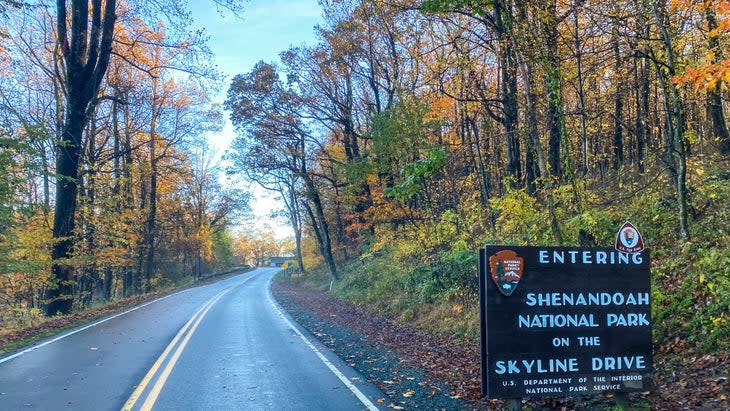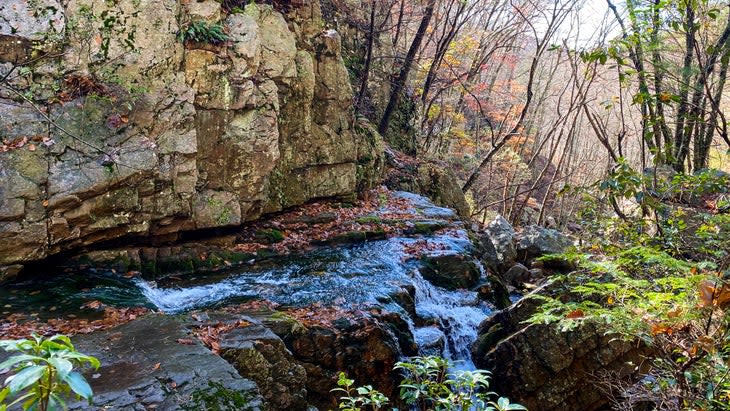A Tough Choice: Shenandoah National Park or Great Smoky Mountains?
Outside
63 Parks Traveler started with a simple goal: to visit every U.S. national park. Avid backpacker and public-lands nerd Emily Pennington saved up, built out a tiny van to travel and live in, and hit the road, practicing COVID-19 best safety protocols along the way. The parks as we know them are rapidly changing, and she wanted to see them before it's too late. Shenandoah is her 50th park visit.
It was pitch-black and raining as I pulled my van into the parking lot for Old Rag Mountain, praying for a coveted space to hike northern Virginia's most popular trail. At 3,284 feet, the peak isn't the tallest in Shenandoah National Park, but it has developed a notorious reputation over the past several decades for being steep, rocky, and unrelenting. It also has some of the best views of the Blue Ridge Mountains and of endless rolling farmlands below. Over the course of a 9.5-mile circuit trail, hikers can expect to gain and lose 2,348 feet of elevation on narrow switchbacks, through tight chimney squeezes, and during teeth-gritting climbs across lichen-blotched Old Rag granite.
Sunlight crept into the haze of clouds that blanketed the eerie forest around me, and I set off on the dirt singletrack beneath a canopy of oak and hickory. The last of the autumn colors were fading fast, and the sodden ground my boots squished across was carpeted in a patchwork of fallen leaves.
What was once a muddy woodland trail soon turned into a steep scramble, and I inched my way upward, careful not to slip on the slate-gray rocks beneath my feet as the downpour intensified. It was 46 degrees outside, and I was drenched to the bone. Atop the first summit, I gazed at a panoramic view of, well, clouds. The mountain's famously epic vistas had been replaced by a veil of glowing white vapor, and I shivered as I remembered that, like it or not, nature won't always provide good weather just because you happen to take a hike.
The next day, however, the weather gods smiled at me, and I was able to take in one of the park's premier attractions--Skyline Drive--as brilliant rays of sunlight and thin carpets of clouds brushed their way across the Virginia foothills.

Skyline Drive is one of the most well-known scenic roadways in the country. Constructed in the 1930s and stretching for over 105 miles, the pavement undulates across the Blue Ridge Mountains, providing visitors with sweeping views of wooded hilltops, rocky peaks, and swaths of agricultural fields. To the south, it's hitched to the Blue Ridge Parkway, which was the most visited spot in the entire national park system last year.
I steered my van onto the mountaintop road and traversed its entire length over the course of a day, pulling over to hike the ten-mile Riprap Trail, a forested loop that descends to a burbling creek and passes several small waterfalls before climbing a half dozen switchbacks to meet the Appalachian Trail, which bisects the park for 101 miles. As the temperature warmed up, my enthusiasm began to wane in the sticky East Coast humidity. By the end of the trek, I was ready to be back in my air-conditioned van.

At sunset I stopped at the Jewell Hollow Overlook as millions of fluttering, rust-tinted leaves caught the fading light. I felt my lips curl into a satisfied grin as I stared down at an impossibly green carpet of rural farmland. Yes, I thought to myself, there is an enormous, accessible, and wild park for east coasters to enjoy--and it isn't named Great Smoky Mountains.
https://www.instagram.com/p/CHTkdEzBdDW/
63 Parks Traveler Shenandoah Info
Size: 197,439 acres
Location: Northern Virginia, 70 miles from Washington, D.C.
Created In: 1935 (national park)
Best For: Scenic drives, hiking, bird-watching, horseback riding, backpacking
When to Go: Though precipitation remains relatively steady across all four seasons, spring (26 to 66 degrees) and fall (30 to 68 degrees) have, by far, the best temperatures for hiking. Summer (53 to 76 degrees), though popular, also tends to be muggy, while winter (18 to 39 degrees) is often icy and offers the most solitude.
Where to Stay: Shenandoah operates five car-friendly campgrounds within its boundaries. Most sites are equipped with picnic tables, fire rings, and access to flush toilets. If you've always wanted to backpack a portion of the fabled Appalachian Trail, you're in luck, because 101 miles of it runs through the center of the park. Simply choose a section, apply for a backcountry permit, and lace up your boots.
Mini Adventure: Motor across Skyline Drive. Set aside an entire day for this 105.5-mile journey, which winds between the northern terminus of Front Royal and the southern town of Rockfish Gap. When it's clear, views stretch for miles across the Blue Ridge Mountains and their foothills. Popular pullouts include Old Rag Overlook, Hogback Overlook, Thornton Hollow Overlook, and the Point Overlook.
Mega Adventure: Scramble up Old Rag Mountain. Get to the parking lot before 7 A.M. and get ready to feel your legs burn on this all-day, 9.4-mile circuit hike that quickly gains 9,238 feet elevation before topping out to some seriously sweet Blue Ridge views. Along the way, keep your eyes peeled for glimpses of black bears and white-tailed deer. Splurge on dinner at the Three Blacksmiths restaurant (book a reservation in advance) in the charming village of Sperryville, not far from the Panorama park entrance.
For exclusive access to all of our fitness, gear, adventure, and travel stories, plus discounts on trips, events, and gear, sign up for Outside+ today.]]>

